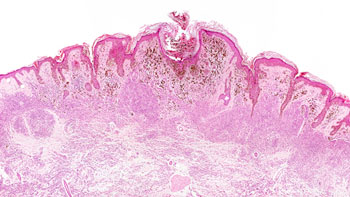Candidate Melanoma Drug Disrupts Translation Initiation Factor Complexes
By LabMedica International staff writers
Posted on 09 Dec 2015
A potentially game changing drug for the treatment of malignant melanoma works by breaking up the translation initiation complexes that the cancer cells require in order to translate mRNA (messenger RNA) into proteins.Posted on 09 Dec 2015
The small molecular weight drug SBI-0640756 (SBI-756), which was identified and characterized by investigators at the Sanford Burnham Prebys Medical Discovery Institute (La Jolla, CA, USA), is a first-in-class inhibitor that targets eIF4G1 (eukaryotic translation initiation factor 4 gamma 1) and disrupts the eIF4F (eukaryotic translation initiation factor 4F) complex, which is composed of at least EIF4A, EIF4E and EIF4G1/EIF4G3.

Image: SBI-756, a first-in-class compound, halts melanoma growth by disrupting protein production (Photo courtesy of Sanford Burnham Prebys Medical Discovery Institute).
Eukaryotic initiation factors (eIFs) are proteins involved in the initiation phase of translation. These proteins help stabilize the formation of the functional ribosome around the start codon and also provide regulatory mechanisms in translation initiation. They form a complex with the small 40S ribosomal subunit and Met-tRNA, which is called the 43S pre-initation complex (PIC). The 43S PIC recognizes and binds the five-prime cap structure of messenger RNA and promotes ribosomal scanning of mRNA to the AUG start codon. Recognition of the start codon by the Met-tRNA promotes GTP hydrolysis of specific initiation factors, resulting in the 60S ribosomal subunit binding to create the 80S ribosome.
The investigators reported in the November 24, 2015, online edition of the journal Cancer Research that SBI-756 impaired the eIF4F complex assembly independently of mTOR (mammalian target of rapamycin) and slowed growth of BRAF-resistant and BRAF-independent melanomas. SBI-756 also suppressed AKT and NF-kappaB signaling. In the gene expression signature patterns elicited by SBI-756, DNA damage and cell-cycle regulatory factors were prominent, with mutations in melanoma cells affecting these pathways conferring drug resistance.
SBI-756 inhibited the growth of NRAS, BRAF, and NF1-mutant melanomas in vitro and delayed the onset and reduced the incidence of Nras/Ink4a melanomas in vivo. Furthermore, combining SBI-756 and a BRAF-inhibitor attenuated the formation of BRAF-inhibitor-resistant human tumors.
“The ability of this compound to delay or eliminate the formation of resistant melanomas is very exciting,” said senior author Dr. Ze’ev Ronai, scientific director of the Sanford Burnham Prebys Medical Discovery Institute. “The unique target of SBI-756 makes it especially promising for use in combination therapy. A major issue limiting the effectiveness of current melanoma therapies is that tumors become resistant to treatment. Combining drugs that come at a melanoma from different angles may help overcome the problem of drug resistance.”
“It appears that the dose we need to administer is very low. Even in the experiments where the drug was administered to mice with tumors over a significant period of time, we have not found any toxicity,” said Dr. Ronai. “We hope that we are going to come up with the next generation of the compound that can go into clinical trials—first in melanoma but likely in other tumors.”
Related Links:
Sanford Burnham Prebys Medical Discovery Institute














